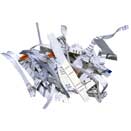(This blog post is third in a new series we will be writing here at Hipcycle on the materials that go into our products. Previous posts were on glass and metal.)
When I was a little girl, I was obsessed with paper. My best friend and I would play “office” for hours. We would shuffle paper around, staple it, paperclip it, cut it, file it, “mail” it…. Ah the magic of paper! I have always loved paper. I can see that this gene was inherited by my son, too, because he’s always busting into the recycling bin to create paper airplanes, swords and other random crafts/weapons. There are indeed limitless uses for this magical product.
I wanted to learn more about paper (the production, use and reuse of) so I decided to do a little research and here is what I found.
The Egyptians invented paper over 6,000 years ago by weaving reeds or other fibrous plants together and binding them into a flat sheet, which was called Papyrus (root of the word paper). In China, some 5,000 years later, paper evolved to more of a cloth-like substance when they mixed mulberry bark, hemp, cotton, linen and water together. These “rags” were used for the next 1700 years. Paper making techniques made its way around the world and into Europe. In 1453, German inventor Johanness Gutenberg created the moveable type printing press and thus followed a boom of book production (and literacy rates!) The increase in demand led to the need for alternative products to create paper and by 1843 ground wood became the material of choice.
To day, there are 300 million metric tons of paper products produced and consumed in the world every year, using an estimated 4 billion trees. And, unfortunately, the process of converting trees to paper is not a clean one. According to the U.S. Environmental Protection Agency, millions of pounds of highly toxic chemicals are released into the environment from paper making plants around the world. These toxins include toluene, methanol, chlorine dioxide, hydrochloric acid and formaldehyde … into the water and air. Yuck!
day, there are 300 million metric tons of paper products produced and consumed in the world every year, using an estimated 4 billion trees. And, unfortunately, the process of converting trees to paper is not a clean one. According to the U.S. Environmental Protection Agency, millions of pounds of highly toxic chemicals are released into the environment from paper making plants around the world. These toxins include toluene, methanol, chlorine dioxide, hydrochloric acid and formaldehyde … into the water and air. Yuck!
Recycling efforts around the world have managed to recover 43 percent of all the paper and paper products and therefore save millions of trees. And, while recycling paper is fantastic (energy consumption reduced by recycling vs raw production is between 40-64%) it still requires more fossil fuels.
The idea of upcycling is not a new one. The concept has been around for decades, but the term was first coined back in the 90’s and has seen an increase in use in recent years. When you purchase a product out of upcycled material, such as paper, you are keeping that product out of the landfill OR allowing it to bypass the recycling process (and the resources it takes to recycle) all together. Upcycling paper into useable products creates a "cleaner," longer life cycle.
Upcycled paper products at Hipcycle include: vases, bowls, frames, trashcans, pencil holders and more. We also have a nice list of tutorials on upcycling the paper around your home. You can find those here. Our tutorial expert, Leanna, actually just finished a new post on upcycling paper into Paper Feathers. So many fun uses for discarded paper!
I still love paper, but these days I’m a responsible paper lover! Especially of this fabulous bowl that I have filled with pens!
How about you? What are your favorite upcycled paper products? Comment below.
Susan is Goddess of Marketing at Hipcycle and Get-It-Done Guru of Get Susan Marketing. She spends her weekends chasing after two active boys, sifting through her husband's garage sale finds and attempting to work on upcycling projects of her own.


